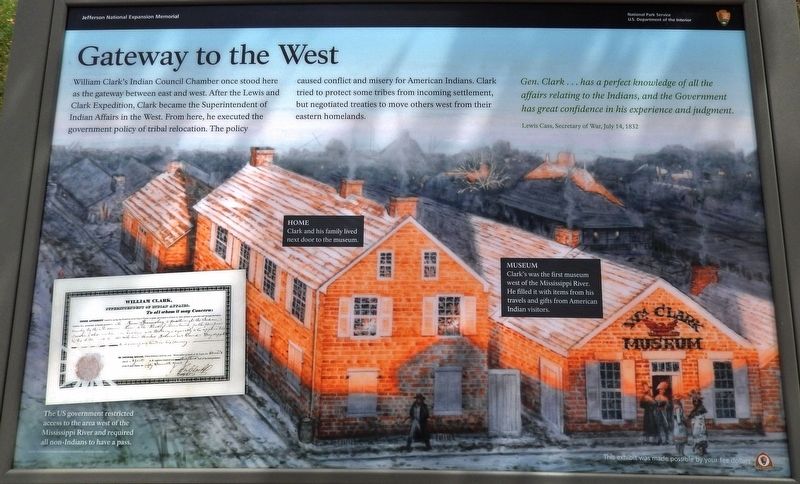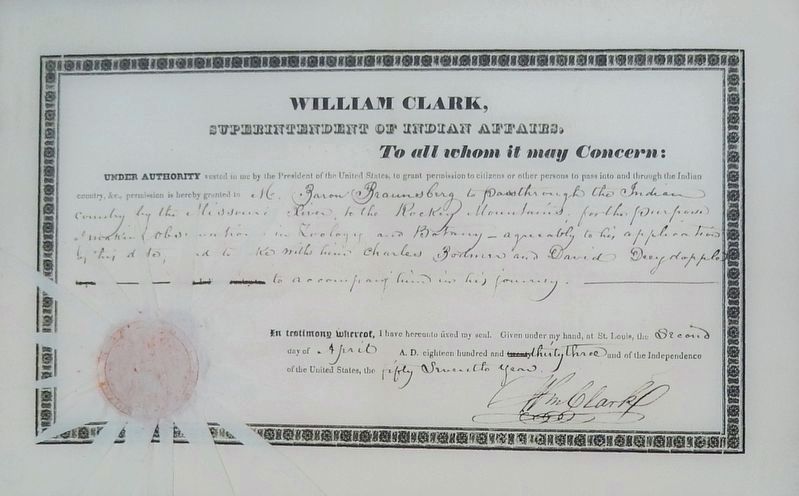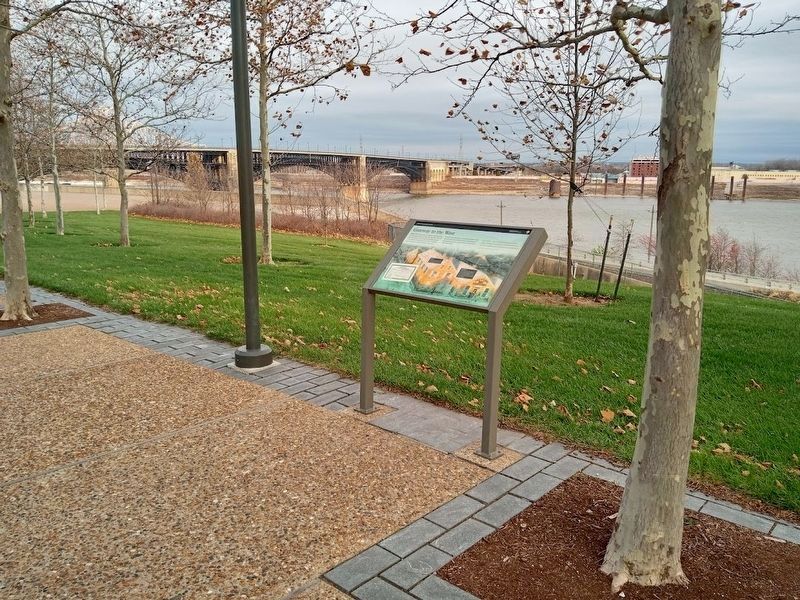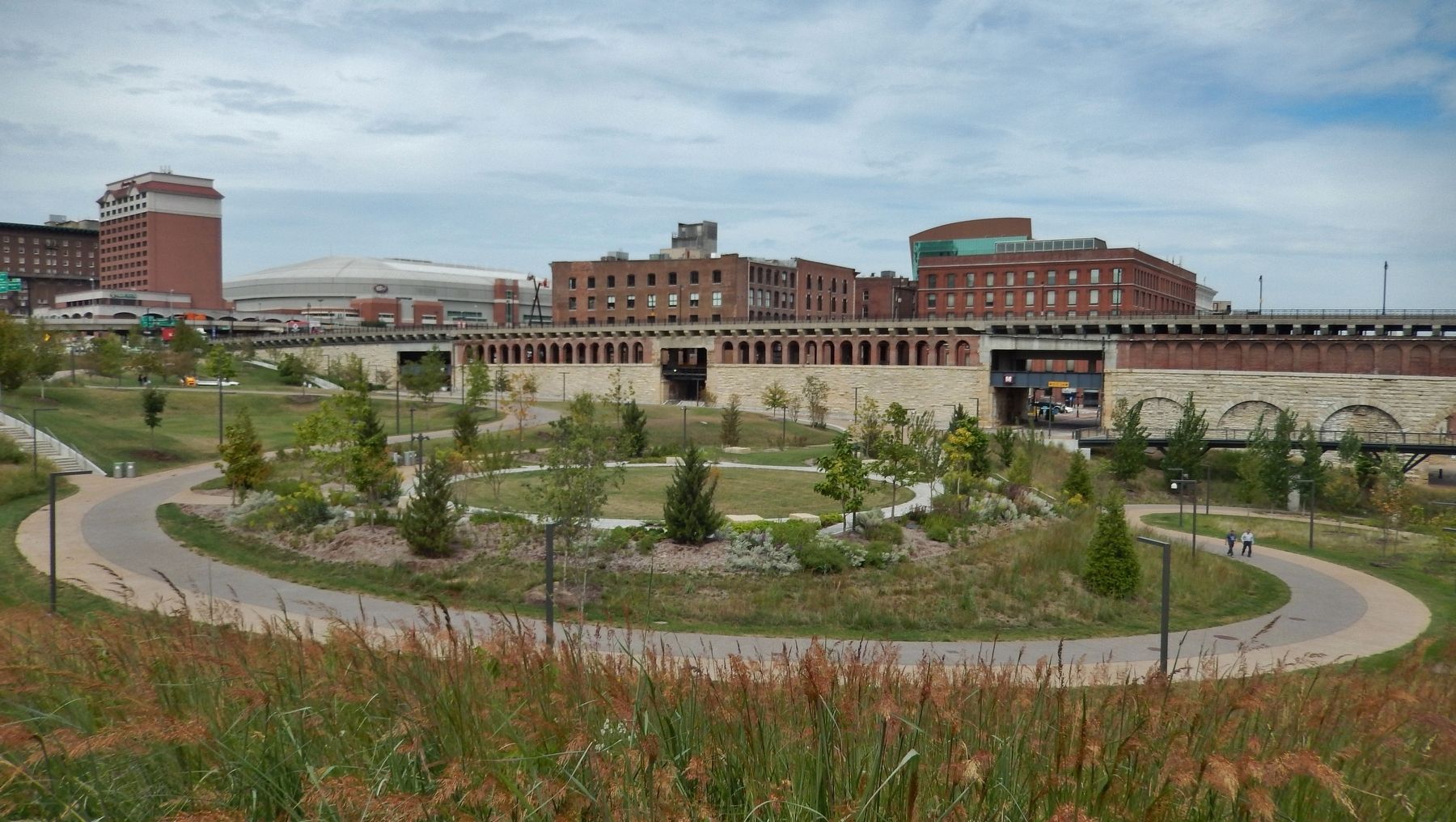Downtown in St. Louis, Missouri — The American Midwest (Upper Plains)
Gateway to the West
Jefferson National Expansion Memorial
— National Park Service, U.S. Department of the Interior —
William Clark's Indian Council Chamber once stood here as the gateway between east and west. After the Lewis and Clark Expedition, Clark became the Superintendent of Indian Affairs in the West. From here, he executed the government policy of tribal relocation. The policy caused conflict and misery for American Indians. Clark tried to protect some tribes from incoming settlement, but negotiated treaties to move others west from their eastern homelands.
Gen. Clark… has a perfect knowledge of all the affairs relating to the Indians, and the Government has great confidence in his experience and judgment.
Lewis Cass, Secretary of War, July 14, 1832
William Clark Home & Museum
Clark and his family lived next door to the museum. Clark's was the first museum west of the Mississippi River. He filled it with items from his travels and gifts from American Indian visitors
Erected by National Park Service, U.S. Department of the Interior.
Topics. This historical marker is listed in these topic lists: Native Americans • Settlements & Settlers.
Location. 38° 37.652′ N, 90° 11.018′ W. Marker is in St. Louis, Missouri. It is in Downtown. Marker can be reached from Walnut Street east of Memorial Drive, on the left when traveling east. Marker is located on the Gateway Arch trail, about 1/10th mile north of the arch, in Jefferson National Expansion Memorial Park. Touch for map. Marker is in this post office area: Saint Louis MO 63102, United States of America. Touch for directions.
Other nearby markers. At least 8 other markers are within walking distance of this marker. Action and Reaction (within shouting distance of this marker); Speedy Delivery (about 300 feet away, measured in a direct line); Curves Ahead (about 300 feet away); The Captains' Return (about 400 feet away); Miles of Steamboats (about 700 feet away); The James B. Eads Bridge (about 700 feet away); Pierre Laclede (about 700 feet away); The Gateway Arch (approx. 0.2 miles away). Touch for a list and map of all markers in St. Louis.
More about this marker. Marker is a large composite plaque, mounted horizontally on waist-high posts. Marker is located at the approximate position of Clark's Home and Museum.
Also see . . .
1. William Clark. Forever linked to the epic achievements of the Lewis and Clark Expedition, William Clark returned from that adventure to become a respected administrator of Indian affairs during the early years of American expansion into the West. When Missouri became a state in 1820, Clark failed in his bid to be elected governor and returned to a position in Indian affairs. In 1822 he was named Superintendent of Indian Affairs at St. Louis,
a post which during these years often involved supervising the removal of eastern tribes to lands assigned to them in what would become eastern Kansas. Clark remained superintendent until shortly before his death in 1838, winning a reputation for fairness and honesty from whites and Indians alike. (Submitted on August 28, 2018, by Cosmos Mariner of Cape Canaveral, Florida.)
2. William Clark and His Indian Museum. Popularly called the “Indian Museum,” Clark’s collections were housed in a 100-foot extension that he had added to his house on Main Street. That house, one of the finest in the town, was also where Clark conducted his business as an Indian agent and where representatives of various tribal groups came to seek justice or, at least, a measure of consideration. Clark’s Indian Museum closed sometime after his death, which was in 1838, and the collections were eventually dispersed hither and yon. The building itself, his home and the wing that was both council room and museum, was demolished in 1851, in favor of much-needed warehouses in the burgeoning city. (Submitted on August 28, 2018, by Cosmos Mariner of Cape Canaveral, Florida.)
Credits. This page was last revised on April 3, 2023. It was originally submitted on August 28, 2018, by Cosmos Mariner of Cape Canaveral, Florida. This page has been viewed 233 times since then and 19 times this year. Last updated on October 15, 2018, by Devry Becker Jones of Washington, District of Columbia. Photos: 1, 2. submitted on August 28, 2018, by Cosmos Mariner of Cape Canaveral, Florida. 3. submitted on April 3, 2023, by Jason Voigt of Glen Carbon, Illinois. 4. submitted on August 28, 2018, by Cosmos Mariner of Cape Canaveral, Florida. • Andrew Ruppenstein was the editor who published this page.



